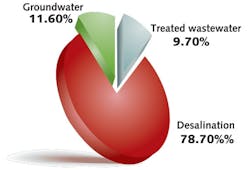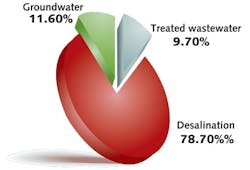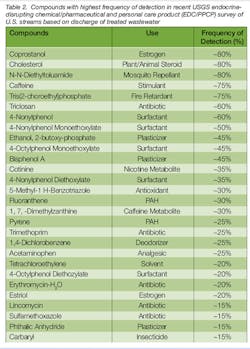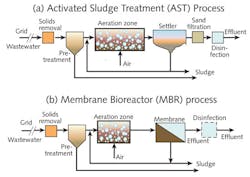Stepping Up Monitoring for the GCC's Water Reuse Drive
Less than 10% of Abu Dhabi city's total water demand is currently met with reused water, yet this is set to increase to meet the needs of a doubling population by 2050. Increases in wastewater reuse should mean utilities step up their water monitoring to detect emerging contaminants/micropollutants, say Farrukh Ahmad and Jorge Rodriguez.
The reuse of water is a vital alternative for meeting rising water demand in arid regions of the Arabian Gulf, where fresh water is limited and demand is largely met by energy-intensive seawater desalination.
With little or no availability of fresh water, metropolitan cities such as Abu Dhabi, Doha, and Dubai in countries along the Arabian Gulf rely heavily on costly energy-intensive and high-capacity coastal drinking water plants that desalinate seawater. As a result, Total Water Cycle Management (TWCM) and Integrated Water Resource Management (IWRM), which consider all parts of the water cycle as a potential resource, hold a special meaning in arid urban areas like coastal cities in the Gulf Cooperation Council (GCC) countries.
In contrast, wastewater treatment costs only a fraction of desalination and offers a sustainable solution to meet the burgeoning water demand in water-stressed regions for society's functions that might not require potable-quality water. At present, treated wastewater meets less than 10% of Abu Dhabi city's total water demand (Figure 1), with desalinated water and groundwater meeting 78.7% and 11.6% of the total water demand, respectively.
This leaves much room for improvement for reducing carbon and energy expenditure in water production by shifting from desalinated water to treated wastewater for non-potable end-use demand. Such a shift might be inevitable for countries like the United Arab Emirates (UAE) considering UAE's current per capita water demand of 550L/day is the highest in the world, and that the regional population is expected to almost double by 2050.
Local regulatory initiatives for safe treated wastewater recycling
Recycled water quality standards generally address a limited number of common chemical, physical, biological parameters. Chemical and physical parameters include pH, 5-day biochemical oxygen demand (BOD5), nitrogen, phosphorus, residual chlorine, total suspended solids (TSS), and turbidity.
Microbiological standards typically stipulate acceptable levels of indicator organisms (e.g., fecal coliforms and intestinal enterococci) per fixed volume of recycled water. Additional standards may be set for specific types of end-use, such as limiting heavy metals with high bioconcentration factor (BCF) in irrigation. Some regulators in the region have taken a more innovative and market-based approach to set comprehensive framework for treated wastewater recycling.
Some regulators in the region have taken a more innovative and market-based approach to set comprehensive framework for treated wastewater recycling. For example, take the recent regulations for recycled water initiated by the Regulation and Supervision Bureau (RSB) for the Emirate of Abu Dhabi.
These take steps to define elements of a broader framework for managing environmental risk from biological and non-biological agents encountered during water reuse.
The RSB defines "points-of-transfer" between treated or partially-treated water generators and end-users (Figure 2), at which an environmental risk assessment is required for the treated water based specific to its end-use.
Although this regulatory framework represents a good starting point, many scientific challenges related to assessing the risk of treated water quality remain in ensuring safe transfer and end-use of the water reclaimed from wastewater in Abu Dhabi.
Water quality challenges in treated wastewater reuse
Around the world, water reclamation and reuse is a growing practice. Generally, recycled water is judiciously matched based on its quality to a specific non-potable end-use, such as landscaping, irrigation, fire-fighting and cooling. More recently, water scarcity has prompted several regions to consider treated municipal wastewater or reclaimed water for direct or indirect augmentation of drinking water supplies.
For example, Singapore and Southern California are indirectly augmenting drinking water supplies with treated municipal wastewater that has undergone reverse osmosis treatment followed by UV polishing, while Australia has enhanced its groundwater reserves through an aquifer storage and recovery (ASR) program.
The recycling of treated wastewater, especially the possibility of direct or indirect unrestricted end-use, has brought two scientific uncertainties or problems into sharp focus. One uncertainty is the fate of the large number of natural (e.g., hormones) and synthetic chemicals, such as pharmaceuticals and personal care products (PPCPs), flame-retardants, and preservatives (Table 2), affecting both human and environmental receptors via a variety of mechanisms including endocrine disruption, cytotoxicity, and increased antibiotic resistance.
Over the last decade, this uncertainty has spawned new fields of scientific inquiry such as the field of "emerging contaminants" in the US or "micropollutants" (MPs) in Europe.
Micropollutants, major challenge
The compounds that fall under this broad umbrella of "micropollutants" are typically organic compounds of very diverse functionalities, and these compounds occur in the municipal waste stream at low (i.e., sub- part per million [ppm]) concentrations. Because of these characteristics, MPs are difficult to analyze using instrumentation available at most water utilities.
Their analysis requires sophisticated instruments and techniques such as gas chromatography - mass spectrometry - selective ion monitoring (GC-MS-SIM) and high performance liquid chromatography - tandem mass spectrometry (HPLC-MS/MS).
Micropollutants routinely find their way into wastewater because of their large-scale production and wide-spread use in commercial and consumer products. These compounds tend to persist in treated wastewater because conventional wastewater treatment processes operated in the region, such as activated sludge treatment (AST) and membrane bioreactor (MBR) (Figure 3), do not target their removal. Widely varying removal rates, often dependent on the operating conditions, have been reported for MPs in conventional wastewater treatment processes.
Therefore, utilities planning to practice indirect augmentation of potable water supplies use conventional wastewater treatment only as a pre-treatment for more advanced treatment such as reverse osmosis (to remove biological agents such as microbes and viruses, and charged molecules) followed by UV polishing (to remove photolyzable chemicals).
Monitoring improvements needed
The other major uncertainty is the effective monitoring of pathogens and other biological agents present in treated wastewater. All water, even tap water and bottled drinking water, contains complex microbial communities that are, for the most part harmless to humans. Unlike chemical contaminants, microbes can multiply in the treatment system. Discerning potentially pathogenic microbes from such present background diversity is a difficult task that cannot be achieved by simply monitoring of bacterial numbers since these are uninformative regarding the types of microbes present.
Moreover, monitoring pathogens using conventional methods based on indicator organisms have been demonstrated to be grossly inadequate in detecting both the presence and levels of pathogens, especially in warm and hot climates. Therefore, the implementation of modern molecular biological techniques, such as polymerase chain reaction (PCR) and high-throughput or metagenomic DNA sequencing, can provide cost-effective and detailed quantitative analysis of microbial community composition, which includes pathogens.
These techniques, coupled with the field of quantitative microbial risk assessment (QMRA) borrowed from food microbiology, but applied specifically to water reuse, offer a scientifically robust way of assessing any health risk from disease vectors in treated wastewater.
In conclusion, the goal of safe and sustainable water reuse can only be accomplished with a decision rationale that is deeply rooted in scientific and technical understanding of these harmful chemical and biological constituents present in wastewater, their fate in the wastewater treatment process, and the health risk their residuals in reclaimed water pose to human and animal populations.
Author's note: Farrukh Ahmad is associate professor and Jorge Rodriguez is an assistant professor for water & environmental engineering from the Masdar Institute of Science and Technology, Abu Dhabi, UAE. For more information on wastewater reuse in Abu Dhabi, please email: [email protected]




